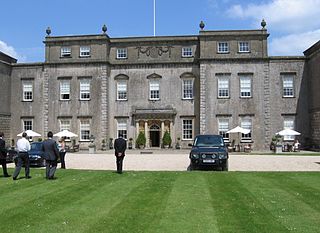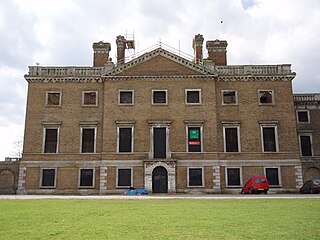


The Manor of Copped Hall (or Coppeed Hall) was located to the south of St Andrew's church in Totteridge, Hertfordshire, in an area that is now part of the London Borough of Barnet.



The Manor of Copped Hall (or Coppeed Hall) was located to the south of St Andrew's church in Totteridge, Hertfordshire, in an area that is now part of the London Borough of Barnet.
The early history of the manor is uncertain but it may be the capital messuage or dwelling held in the 16th century by John Copwood who owned it at the time of his death in 1543, leaving a daughter, Sophia. It seems to have passed soon afterwards into the possession of the family of Clyffe. Richard Clyffe held a "manor or capital messuage" in Totteridge at his death in 1566, leaving it to his illegitimate son William Clyffe or Smyth, with remainder to Richard's brother Geoffrey and his son Richard. In the following century it was held by Edward Clyffe, who died about 1635, leaving two sons, William, on whom the property was settled, and Edward. [2]
The manor was bought by Joseph da Costa (1683–1753), a wealthy Portuguese-Jewish merchant, in 1722, when it had formal gardens [3] and a large house. In 1758 it was bought by Abraham Chambers, a London banker. The grounds were later reworked by Humphry Repton to give a more natural appearance. [4]
In the nineteenth century, Copped Hall was for some time owned by William Manning, father of Henry Edward Manning (Cardinal Manning), who was born there in 1808 and sold it in 1831. William's wife Mary Hunter re-designed the grounds, probably with the advice of Humphry Repton, damming the Folly Brook to create the ornamental Darland's Lake.
It was sold by auction in 1850. From 1875 it was occupied by Sir Samuel Bagster Boulton (1830–1918), who enlarged the house. [2]
The house was later known as Darlands. It was demolished in 1928 [5] by George Herbert Kemp, a biscuit entrepreneur. The grounds became a nature reserve in 1971 and currently is a Site of Nature Conservation Interest. [4]

Totteridge is a residential area and former village in the London Borough of Barnet, England. It is a mixture of suburban development and open land situated 8 miles (13 km) north north-west of Charing Cross. It is part of the Whetstone postal district (N20).

Humphry Repton was the last great designer of the classic phase of the English landscape garden, often regarded as the successor to Capability Brown. His style is thought of as the precursor of the more intricate and eclectic styles of the 19th century. His first name is often incorrectly spelt "Humphrey".

Eggesford is a parish in mid-Devon, without its own substantial village. It is served by Eggesford railway station on the Exeter to Barnstaple railway line, also known as the Tarka Line.
William Manning was a British merchant, politician, and Governor of the Bank of England.

Ston Easton Park is an English country house built in the 18th century. It lies near the village of Ston Easton, Somerset. It is a Grade I listed building and the grounds are listed Grade II on the Register of Historic Parks and Gardens.

Copped Hall, also known as Copt Hall or Copthall, is a mid-18th-century English country house close to Waltham Abbey, Essex, which has been undergoing restoration since 1999. Today, Copped Hall refers to the upstanding house, while Copt Hall or Copthall refer to the older Tudor and earlier houses. Copped Hall is visible from the M25 motorway between junctions 26 and 27.

Brondesbury Park is a suburb and electoral ward of the London Borough of Brent. It is the part of Brondesbury which is not interwoven with Kilburn due to the naming of a major tube station (Kilburn) and is centred on Brondesbury Park railway station and the street, an avenue, which shares its name. The area has a number of open spaces, primarily Queen's Park and Tiverton Green.

Lathom House was a large country house in the parish of Lathom in Lancashire, England. Built between 1725 and 1740, the main block was demolished in 1925.

Milton Hall near Peterborough, is the largest private house in Cambridgeshire, England. As part of the Soke of Peterborough, it was formerly in Northamptonshire. It dates from 1594, being the historical home of the Fitzwilliam family, and is situated in an extensive park in which some original oak trees from an earlier Tudor deer park survive. The house is a Grade I listed building; the garden is Grade II*.

Darland's Lake Nature Reserve is a nature reserve south of Totteridge Village in Barnet, England. It is owned by the London Borough of Barnet and was managed from 1971 by the Hertfordshire and Middlesex Wildlife Trust, and more recently by the borough council. In 2007 the council spent £215,000 on repairing the dam and other works, and then proposed leasing the reserve to the Wildlife Trust. The transfer did not take place and in September 2017 a trust was set up by the London Wildlife Trust and local residents associations which took over the management of Darland's Lake. In 2020 Darlands Conservation Trust launched an appeal to raise £450,000 for excavation to prevent the lake drying up.

Stansted or Steanstead Hall is located in Stansted Mountfitchet, Essex, East of England, United Kingdom. It was the country seat of the Earls of Essex during the reign of Henry VIII of England.

Rode Hall, a Georgian country house, is the seat of the Wilbraham family, members of the landed gentry in the parish of Odd Rode, Cheshire, England. The estate, with the original timber-framed manor house, was purchased by the Wilbrahams from the ancient Rode family in 1669. The medieval manor house was replaced between 1700 and 1708 by a brick-built seven-bay building; a second building, with five bays, was built in 1752; the two buildings being joined in 1800 to form the present Rode Hall.

The Great Budbridge Manor is a manor house just south of Merstone, near Arreton, Isle of Wight, England. Fish ponds on the grounds appear medieval.

Buckhurst Park is an English country house and landscaped park in Withyham, East Sussex. It is the seat of William Sackville, 11th Earl De La Warr.

Sheringham Hall is a Grade II* listed building which stands in the grounds of its park. The house is close to the village of Upper Sheringham in the English County of Norfolk in the United Kingdom. The hall was built on the instructions of Abbot and Charlotte Upcher who engaged the architect and landscape designer Humphry Repton and his son John Adey Repton to build the house and to present designs for the surrounding parkland. Humphry worked on the landscape and John Adey designed the hall. National Trust members and guests have no rights of access across the park and farmland surrounding Sheringham Hall. Access is solely at the discretion of the owners of George Youngs (Farms) Ltd which farms the Sheringham estate. George Youngs (Farms) Ltd is owned by Paul Doyle and Gergely Battha-Pajor who also own the long leasehold of Sheringham Hall.

Barningham Hall is a Grade I listed building which stands in the grounds of the estate called Barningham Winter. Both the hall and estate privately owned. The house is close to the village of Matlask in the English County of Norfolk in the United Kingdom. The house was built for Sir Edward Paston in 1612 although the house seen today is the result of renovations, alterations and enlargement carried out under the control and design of Humphry Repton and his architect son John Adey Repton in 1805.

The Manor of Totteridge was located in Totteridge, Hertfordshire, in an area that is now part of the London Borough of Barnet. The manor was historically associated with the Manor of Hatfield. The original manor house was demolished before 1821 and the manorial estate known as Totteridge Common was transferred to a charity, the Totteridge Manor Association, in 1954.

Fernando Joseph da Costa (1683–1753), alias Joseph Curiel, was a member of a wealthy family of merchants in London of Portuguese-Jewish origins, and the son of Alvaro Jacob da Costa, sometimes considered the founder of the Anglo-Sephardi community in London. He was able to buy Copped Hall in Totteridge, Hertfordshire, and thus became the lord of the Manor of Copped Hall.

Chalfont Park, formerly known as Brudenells and Bulstrodes, is an English country house and estate near the village of Chalfont St Peter in Buckinghamshire.
Higham Lodge or Higham Hill Lodge was a building in Walthamstow built in the late 17th century. It was expanded by the William Dillwyn after he took over the building. Dillwyn married Susan Weston, who inherited nearby High Hill from her father Lewis Weston. The two estates were combined, and High Hill was demolished with Higham Lodge being retained as the family home.
{{cite book}}: CS1 maint: multiple names: authors list (link)